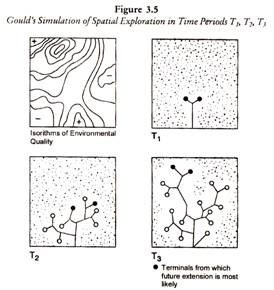Gould’s Spatial Exploration Model of Transport Development

The behavioural model was proposed in 1966 as an alternative to the Taaffe, Morrill and Gould concepts of transport development. It incorporates a random approach and is based upon a simulation of search theory, with the development of a transport network within an area, which contains resources and hazards, or constraints, indicated by isorithms of environmental quality. The developer aims to tap the resources of a previously unexploited area, depicted as a square, by building roads from a port on the coast, which forms one side of this square. As road building proceeds so the developer will encounter the resources and the constraints, such as mountains or rivers, within the environment. In stage one capital is invested in roads, which diverge from the port in straight lines. In stage two, information on the nature of the resources or of the hazards encountered by the advancing roads is fed back to the development who may react in one of two ways. The resource already tappe...